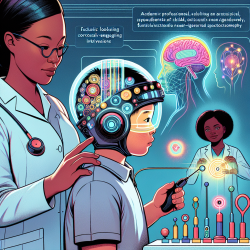Introduction
As practitioners in the field of speech-language pathology, we are constantly seeking ways to improve our therapeutic approaches and outcomes. The recent case study titled "Clozapine-Induced Microseizures, Orofacial Dyskinesia, and Speech Dysfluency in an Adolescent with Treatment Resistant Early Onset Schizophrenia on Concurrent Lithium Therapy" offers critical insights that can enhance our understanding and treatment of speech dysfluency in adolescents with schizophrenia.
Understanding the Research
The case study highlights the development of clozapine-induced microseizures, orofacial dyskinesia, and stuttering in a 17-year-old male with treatment-resistant early onset schizophrenia. This case underscores the importance of recognizing speech dysfluency as a significant side effect of antipsychotic medications, particularly in adolescents. The study also notes the potential exacerbating effects of concurrent lithium therapy.
Key Takeaways for Practitioners
Based on the findings of this study, practitioners can consider the following strategies to improve outcomes for adolescents experiencing similar symptoms:
- Multidisciplinary Approach: Collaborate with psychiatrists, neurologists, and other healthcare providers to ensure comprehensive care. This approach is crucial for addressing both the psychological and physiological aspects of speech dysfluency.
- Monitoring and Assessment: Regularly assess speech patterns and seizure activity in patients on clozapine, especially during dose escalations. Utilize tools like electroencephalograms (EEGs) to detect microseizures.
- Speech Therapy Interventions: Implement tailored speech therapy programs to help patients manage and cope with stuttering. Techniques such as syllable-timed speech may offer benefits.
- Patient and Family Education: Educate patients and their families about the potential side effects of medications and the importance of adhering to therapy plans.
Encouraging Further Research
While this case study provides valuable insights, further research is needed to explore effective treatment modalities for clozapine-induced speech dysfluency. Practitioners are encouraged to contribute to this growing body of knowledge by documenting and sharing their clinical experiences.
Conclusion
Speech dysfluency in adolescents with schizophrenia presents unique challenges that require a data-driven, multidisciplinary approach. By leveraging the findings of this research, practitioners can better support their patients and improve therapeutic outcomes.
To read the original research paper, please follow this link: Clozapine-Induced Microseizures, Orofacial Dyskinesia, and Speech Dysfluency in an Adolescent with Treatment Resistant Early Onset Schizophrenia on Concurrent Lithium Therapy.










